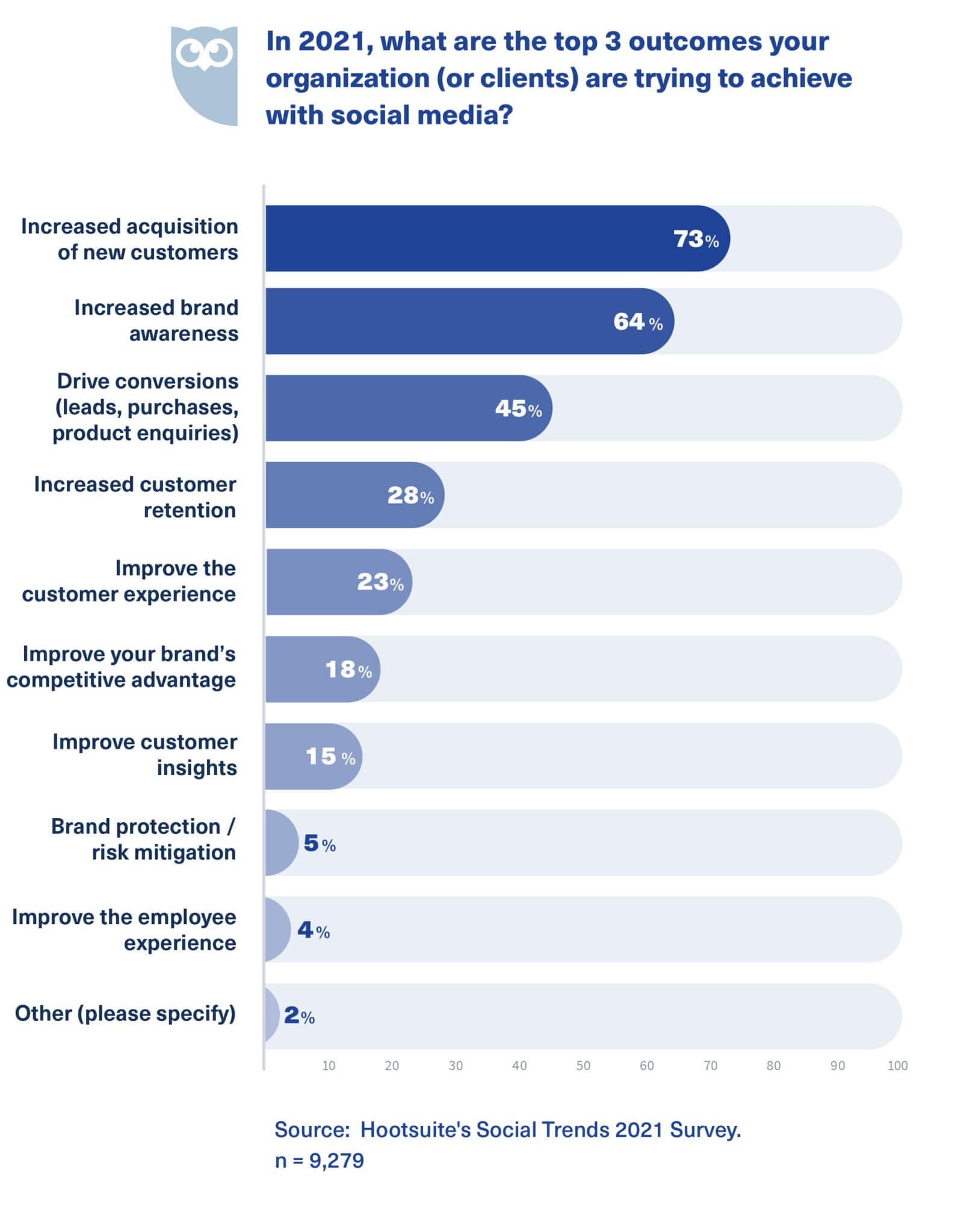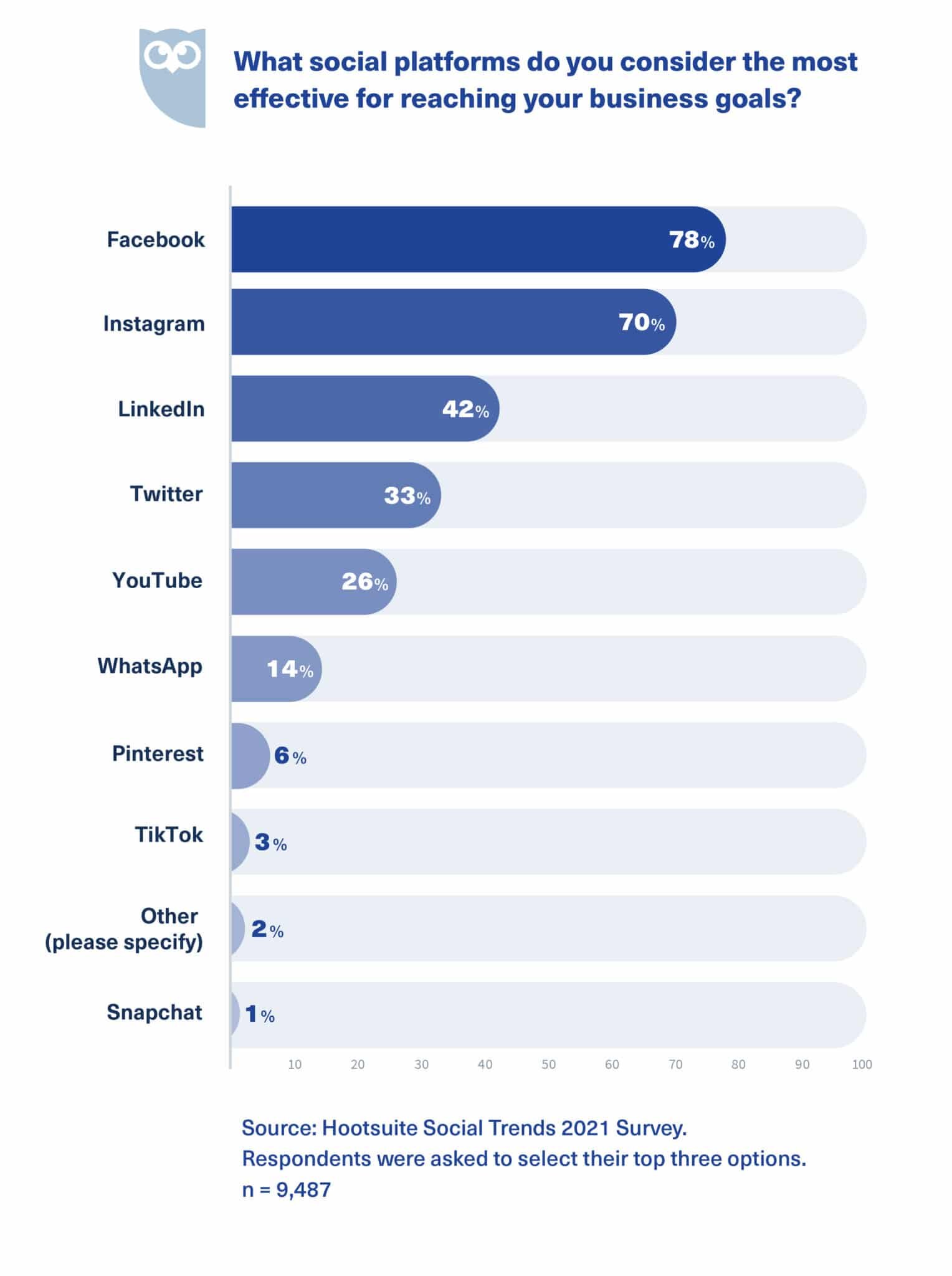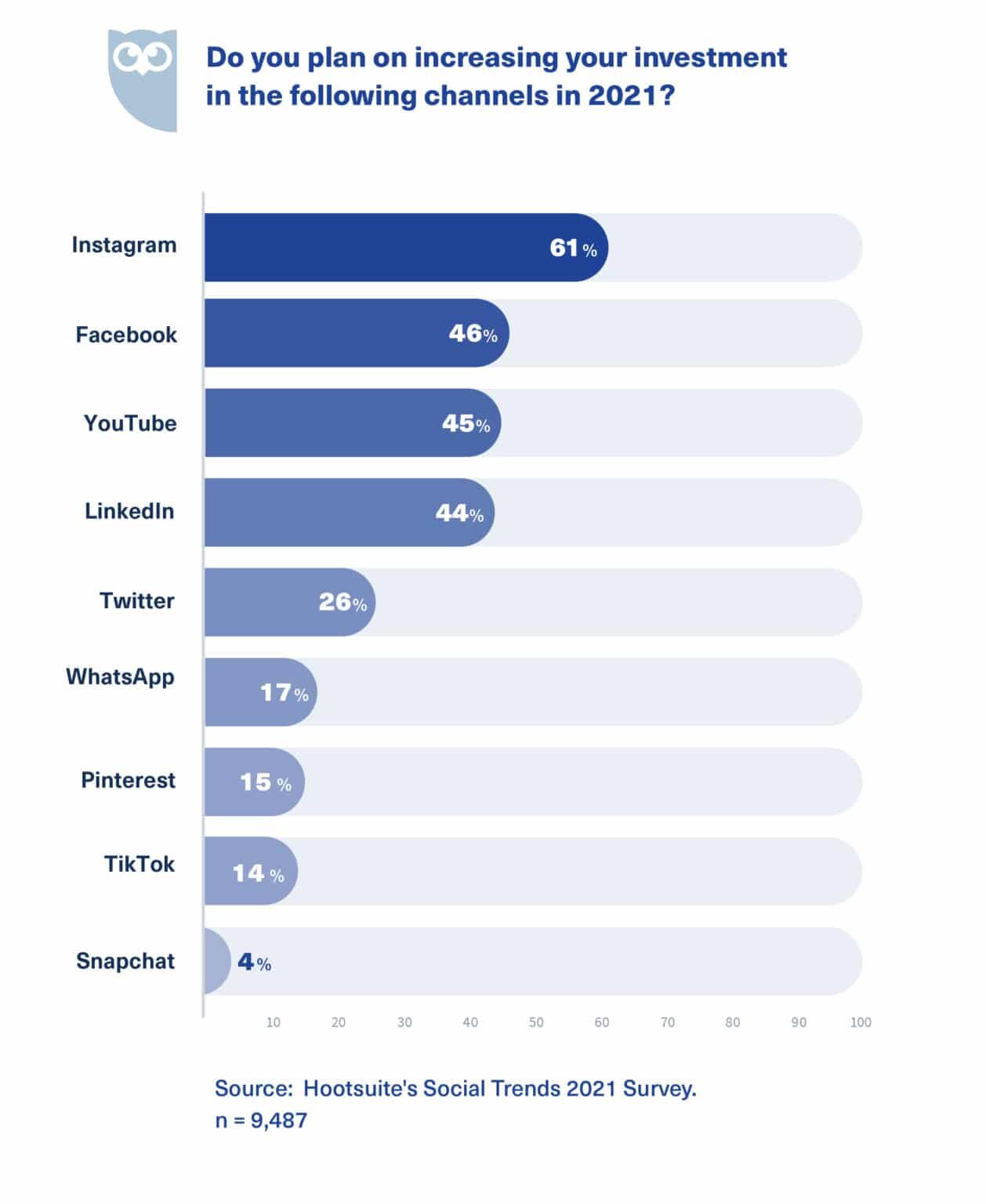Christina Newberry, Sarah Dawley | Hootsuite
It’s an understatement to say this year has changed the way people and businesses use the Internet in general and social media in particular. So how will these new social media trends affect the way we use social networks in 2021?
In the fall of 2020, Hootsuite surveyed more than 11,000 marketers to ask them just that. They followed up with detailed interviews with dozens of industry specialists. Then they combed through the latest published reports and data from some of the most respected sources in the world, including:
· Deloitte
· Edelman
· eMarketer
· Forrester
· GlobalWebIndex
· The CMO Survey
All that information pointed to five key social media trends 2021 will bring to the fore. Here’s what you need to know.
Download Hootsuite’s complete social media report
1. The race to ROI: Social bridges the gap to a new customer experience
Hootsuite asked marketers what was their most important social media goal for 2021. Nearly three-quarters of them said “increased acquisition of new customers.” That’s a major increase since last year, when less than half of marketers said this was their most important social goal.
It’s no shock that brands are focused on bringing in new business. But it’s interesting that only 23% of marketers said “improving the customer experience” is a top goal for social.
The pandemic rolled a wrecking ball through typical offline customer experience efforts. Suddenly, there were no more in-store samples or attractive displays. No more sales events or in-person help from knowledgeable staff.
In 2021, marketers can still drive quick bursts of ROI from new customers using social ads. But they also need to provide online social experiences that help build relationships and brand loyalty.
For example, face-to-face guidance from product experts is the driving force of Clarins’s retail sales and profits. When stores suddenly closed, they needed a new way for customers to consult with Clarins beauty advisors.
Launched just two weeks into the lockdown, their Clarins & Me video consulting service saw more than 450 bookings in the first month alone.
They also tapped Clarins beauty coach Rebecca Jones to post daily skincare videos from home on Instagram Stories. Followers appreciated this DIY approach. Story completion rates jumped from a previous average of 20% to 75%. This was the highest the team had seen on social channels.
Those engaging short social videos create brand loyalty. But they can also drive sales. TikTok is experimenting with in-app purchases. And Taobao, China’s largest eCommerce platform, features short videos on 42% of product pages.
Live streaming events are another great way for brands, experts, influencers, and customers to connect. In China, a Tommy Hilfiger livestream event attracted 14 million viewers. They sold out of 1,300 hoodies in two minutes. In the US, livestream shopping events are predicted to generate $25 billion in sales by 2023.
What you should do in 2021:
Multiply ROI by adding more channels
Every channel you add can improve ROI and effectiveness by up to 35%. Start by adding social user-generated content (UGC) to email marketing campaigns. Or try uniting search and social ads.
Turn inspiration into revenue
Create fun in the online buying process. Use Instagram Live orPinterest as virtual showrooms. Inspire fans by introducing them to things they didn’t know they needed or wanted.
Put social back in shopping
Host live Q&A sessions. Work with influencers. Or share user-generated content. These are all ways to increase buyer confidence in a product they can’t see in person.
Focus on customer loyalty
Social connects organizations to their most loyal customers. Engage in proactive social listening. Then reach out to other teams within your company to fix common complaints.
2. Silence is golden: Brands find their place in the conversation
Sometimes the best thing businesses can do is listen rather than talk. After all, in times of crisis, people want to use social media to distract and entertain themselves. And they want to connect with each other, not brands.
On average, 32% of Gen Z, millennials, Gen X, and baby boomers say “finding funny or entertaining content” is their main reason for using social media. Useful and entertaining ads are most likely to drive purchases.
Successful campaigns this year have helped create connections between people. Or, they’ve provided much-needed moments of levity and fun. These are the reasons people turn to social media in the first place.
Remember all those brands with the nearly identical“unprecedented times” ads? Instead of following those popular social media trends, Coors took a different approach.
They lamented the “sucky, suck, suck, suckiness” of 2020. They launched a social campaign where people could nominate someone who #CouldUseABeer. They then sent 500,000 beers to grateful customers.
Ocean Spray, meanwhile, let a viral social moment unfold organically instead of jumping in with a marketing message.
You’ve probably seen the Ocean Spray challenge. It started when Nathan Apodaca posted a TikTok while cruising on his longboard. He was lip-syncing to “Dreams” by Fleetwood Mac and drinking from a large container of Ocean Spray.
The post quickly went viral. And in true TikTok fashion, people began recreating the video. Celebrities, influencers, US state governors, and even members of Fleetwood Mac jumped on the trend. But Ocean Spray stayed silent for over a week.
Finally, their CEO recreated the video on TikTok. But only after they had bought a new truck (filled with Ocean Spray) for Apodaca. Giving back to the creator rather than just trying to capitalize on the free publicity earned Ocean Spray plenty of goodwill.
Many brands misinterpret new social media trends. They misunderstand what people want from them on social media, and how much people want to interact with them in the first place. Is it really a surprise that 68% of people don’t think brands or companies share interesting content?
In 2021, the smartest brands will understand where they fit into customers’ lives on social media. And they’ll find creative ways of fitting into the conversation instead of trying to lead it.
What you should do in 2021:
Don’t dismiss passive content consumption
The average Facebook user has only shared one post in the last 30 days.
Reach and reaction are much more realistic engagement goals than mass participation. Provide value for the people who see your content, rather than just trying to get them to reshare.
Back up social listening data with search data
It’s not as easy to monitor conversations across Instagram Stories, LinkedIn, TikTok, or private messaging as it is on Twitter or Facebook.
This can skew your insights. Search analysis is a powerful secondary tool because it reflects more of what people are privately thinking.
Replace costly content production with UGC
User-generated content is both cheap and effective for building trust. According to the Edelman Trust Barometer, consumers are more likely to listen to their peers than a brand itself.
3. Way more than OK: A generation ignored by digital marketers booms online
Baby boomers are getting fully onboard with social media trends.
Boomers spent more time online in 2021 using social media, digital video, gaming, and mobile payments. Seventy percentof internet users aged 55-64 have bought something online in the past month. And 37% plan to continue doing so more frequently.
Marketers typically target baby boomers through TV advertising. This is still one of the most effective ways to reach them—for now. But eMarketer forecasts less than half of households will have cable TV by 2024.
Meanwhile, baby boomers are discovering more new brands and products through social media. Especially through Facebook.
The director of marketing at one medical technology company told us why Facebook represents more than half of their media buy.
“It is so effective from a targeting side, but we don’t engage with two-way conversations on our page,” he said. “Our patient population is 65+ and they just talk all the time. They’re basically telling our story for us, so we don’t even need to get involved.”
Getting onboard with new social media trends, Boomers are also exploring and expanding their hobbies online. “We see a really high affinity within that demographic for gardening, travel, art, animals, DIY, and recipes,” says Jim Habig, global head of business marketing at Pinterest.
Most marketing and advertising professionals are under 40. They can sometimes forget about older generations when creating marketing campaigns.
Consider this: 46% of the US adult population is over 50. But only 15% of images containing adults include people in that age segment. Successful marketers in 2021 must better recognize the buying power and growing social savvy of older consumers.
For example, Australian supermarket Woolworths used a Facebook campaign and augmented reality (AR) filter to gain an 11-point lift in brand favorability and a 46-point lift in message association among women aged 55 to 64.
During the campaign, Woolworths rewards members could plant and nurture a virtual Christmas tree using the AR filter. They could also donate their rewards to an environmental charity to have a real tree planted on their behalf. More than 6,000 trees were planted as a result.
The most effective social platforms for 2021
Whether or not boomers are a target audience, more than half of all businesses (60%) are planning to increase their Instagram budget, and almost half are planning to do the same for Facebook, YouTube, and LinkedIn. Notably, for all the hype of TikTok, it has not increased in importance in the investment stack.
Social platforms marketers plan to increase investment in
With overall marketing budgets trimmed in 2021, it’s no surprise that marketers are focusing on familiar favorites, rather than experimenting with newer tactics and platforms.
What you should do in 2021:
Target baby boomers by passions or hobbies
Baby boomers are not all the same. Instead of targeting them by age alone, use passions and hobbies to attract a cross-generational audience.
Pinterest marketing is a great choice for this. It’s a network known for passion projects and planning. It is also the second-most popular social network among boomers (after Facebook).
Include baby boomers in your creative—without stereotypes
Baby boomers do not think of themselves as “old.” But that’s how they’re often depicted in marketing campaigns.
Nearly 70% of people aged 55 to 73 own a smartphone. But just 5% of images show older generations interacting with technology. The Disrupt Aging Collection on Getty Images is a great source of images depicting older generations more accurately.
Use online reviews to build trust
Online reviews influence boomers’ purchasing decisions more than any other online source. The Google My Businessintegration in Hootsuite allows you to monitor and engage with customer reviews on Google alongside social media activity.



